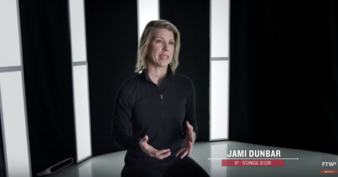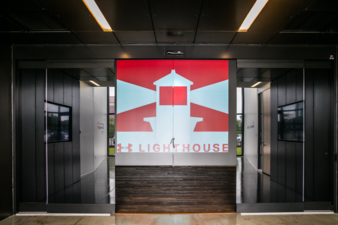17/01/2017 – Lectra/Under Armour — auf Deutsch lesen
What does tomorrow’s textile production look like?
This short question requires a considerably longer answer. At the Lighthouse, Under Armour questions and examines complex processes.
Just recently, Under Armour, the sporting goods producer from Baltimore, Maryland, USA, was ranked by Forbes as the sixth most innovative company in the world. In mid-October 2016, Jami Dunbar, Vice President, Lighthouse Apparel by Under Armour, gave an impressive talk at the “Lectra Fashion Forward Event” in Bordeaux, shedding light on the ideas behind the Lighthouse.
What is the Lighthouse?
In answer to this question, Jami Dunbar states: “It’s our vision for tomorrow’s production, it’s our new production and design centre in the heart of Baltimore.” The underlying idea can be described as follows: Product designers, technical designers, manufacturers, institutions and universities assemble at the Lighthouse to research and work on new technologies and methods. Dunbar continues: “The production of apparel and footwear is still based on technologies that are a hundred years old. At the Lighthouse, we come together to develop new technologies so that we may manufacture products on a smaller scale, enhance efficiency and quality, and bring products to market more quickly.”
Building new on old
Under Armour’s Lighthouse project revolves around developing innovative processes for innovative products. “It’s then that we start thinking like entrepreneurs,” says Dunbar. In effect, the objective is to “spotlight” efficiency, quality, response times etc.
One of Lighthouse’s defining characteristics is its tenacity in questioning the status quo – such as: “What would happen if designers could work directly with production?” At the Lighthouse, best practices are first introduced to the pilot lines for apparel and footwear which are located alongside each other. The technologies for the different sectors are examined in detail, allowing the unknown to become known and the processes of experimentation to continue. “We test and test and test. If the processes run well, we incorporate them in the pilot lines. If they run well there too, we roll them out in our factories,” says Dunbar.
Virtualisation and 3D technologies
The Lighthouse accommodates a research laboratory for virtualisation – containing everything the 3D heart desires from a body scanner to other 3D technologies. Other highlights include a 3D printing lab, in which textures and small parts such as buttons and facings can be created overnight, and a space for modern production, in which designers can experiment with and implement their designs.
The strategy and portfolio development team puts to the acid test all the proposals and plans developed at the Lighthouse and if they are found to be sound, they are transferred to existing production processes. The Lighthouse can, therefore, be seen as the home of optimisation, new processes and a new kind of global production process.
Localised production and consumption
“We’re striving for a new level of optimisation,” says Dunbar, continuing: “We devise a principle on how to construct materials and components. It’s a kind of modular system that enables us to make our products simpler, more beautiful and more useful. We examine the entire product development process. Let me explain by way of example: Let’s say we start by observing and analysing the athlete in motion together with our product. How much faster could we do this, if we could fully rely on virtual technologies? This is why we use the innovative solutions from Lectra to connect virtual processes with back-end automation.”
"How do we revolutionise?"
In answer to this question, Dunbar states: "The Lighthouse brings together pioneers who work on innovative products and processes. We believe in cooperating with the “Best in our Class”, which includes companies such as Lectra, 3DMD and BMS. We aim to create new production technologies that can be used all over the world." Continuing, she sheds light on Under Armour’s main objective: “We want to use the Lighthouse to pave the way for the localised manufacture of our products wherever they are being sold,” concluding: “It no longer makes sense to pursue the cheapest labour around the world. Local-for-local allows us to dictate exactly where our products are made. And that means we’re developing the best practices for our brands which are then implemented in our companies and partner companies: We produce in the USA for the USA, in Europe for Europe and in Brazil for Brazil.”





